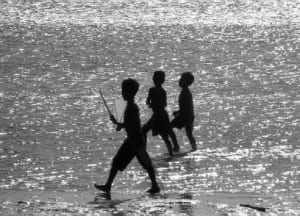
Only 250 miles separates the island of Madagascar from the southeast coast of Africa. The short distance between the two land masses traditionally led the outside world to assume that the native inhabitants of Madagascar – known as the Malagasy – originally came from the west, probably from the present day southeast African nation of Mozambique. Yet upon closer examination of the Malagasy’s language and their physical features, many scholars began to question this notion. The Malagasy of the central plateau of Madagascar, known as the Highlanders, had light skin and facial features more akin to Southeast Asia or Indonesia. They also practiced a rice culture that was not unlike the rice cultures of Asia. And yet the coastal Malagasy, known as the Côtiers, seemed just the opposite. They had darker skin and curly hair that was more similar to modern day Africans.
But both the Highlanders and the Côtiers speak the same language, which shares 90% of its vocabulary with a language spoken today in Southeast Borneo, and which has been officially classified as a branch of the Austronesian language family called West Malayo-Polynesian. So how could a significant portion of Malagasy seem to share more in common with a region 5,000 miles away than they do with mainland Africa? Trying to find the answers to these questions has vexed archaeologists, historians and linguists for generations. Over the past several years, geneticists have entered the fray to try and unravel the mysterious origins of the Malagasy. Their most recent effort appears this week in Molecular Biology and Evolution.
This study, led by Sergio Tofanelli of the University of Pisa, built upon a 2005 study by Matt Hurles and colleagues that was the first genetic exploration of the Malagasy people. But Tofanelli and his colleagues wanted to dig even deeper into the genetic history of the Malagasy. So they took the data analyzed by Hurles in addition to new DNA samples that were collected from people across the island of Madagascar.
They focused on two regions of the human genome often used in genetic ancestry studies: the mitochondrial DNA (mtDNA) and the Y chromosome. Because the mtDNA is used to trace maternal ancestry, and the Y chromosome to trace paternal ancestry, analyzing both in the same study can give a more complete picture of a group’s genetic history.
Tofanelli and his research team examined the mtDNA and Y chromosomes of Malagasy individuals scattered across the island, from both the Highlander and Côtiers groups. They were searching for any clues that would give an exhaustive understanding of how and when the island of Madagascar was first settled, and by whom.
The researchers’ analysis revealed a mixture of both African and Asian genetic ancestry, in both the Highlanders and the Côtiers, which is perhaps contrary to the two groups’ physical apperance. So what does this mean? That even the Côtiers people, who often look more African in appearance, have an ancestry that traced back to Asia, specifically Borneo. These results fit well with Hurles’ study and with what linguists have been saying for years; that the Malagasy language – while clearly tracing back to Borneo – also has some African elements that are significant.
The results from these analyses then begged the next question — how and when did the earliest inhabitants of Madgascar arrive on the island? Was it in two separate migrations – one from the east and one from the west – or did the Asian/African genetic make-up of the Malagasy exist prior to their first steps on Madagascar? It is easy to assume that any intermarriage between Africans and Southeast Asians happened after each arrived on the island. In fact, Tofanelli describes the genetic make-up of the Malagasy as a consequence of “the encounter of people surfing the extreme edges of two of the broadest historical waves of expansion” in human history. He is referring to the sub-Saharan African Bantu expansions that began 5,000 years ago and swept across Africa from Cameroon to Mozambique and southern Africa, and the Austronesian expansions about 4,000 years ago when seafarers journeyed from Taiwan to Borneo and beyond.
But Tofanelli proposes an alternative hypothesis as well. He argues for a long history of contact between Bantu-speaking Africans and seafarers from Borneo dating back thousands of years. As evidence he cites banana cultivation in Cameroon and Uganda that can be traced back to Southeast Asia, as well as the introduction of humped cattle into Africa from Asia. If the Southeast Asians and eastern Africans shared farming techniques, it stands to reason that they may have shared genes as well. Thus the people of Madagascar may have not simply been Africans and Southeast Asians arriving on the island from opposite directions, but rather they represent a more complex genetic history of proto-Malagasy arriving on Madagascar about 2,300 years ago, already containing a mixture of Asian and African ancestry.
This hypothesis most certainly needs additional evidence and data before it can be supported, but it brings a new level of understanding to the mysterious origins of the Malagasy.